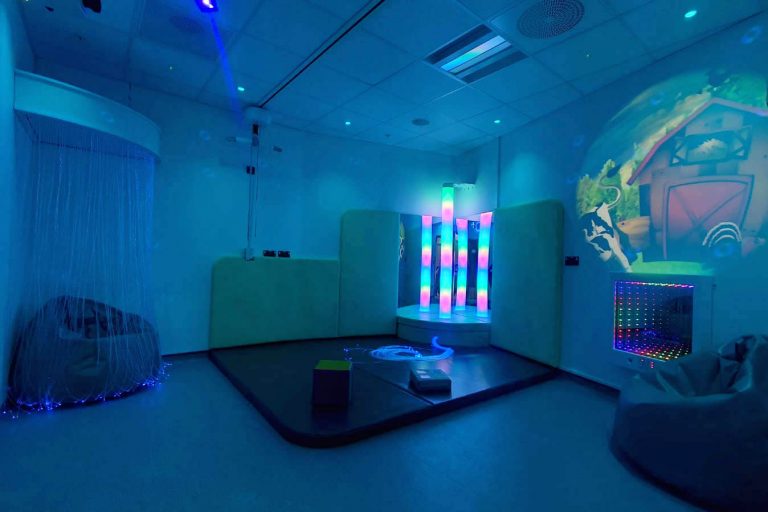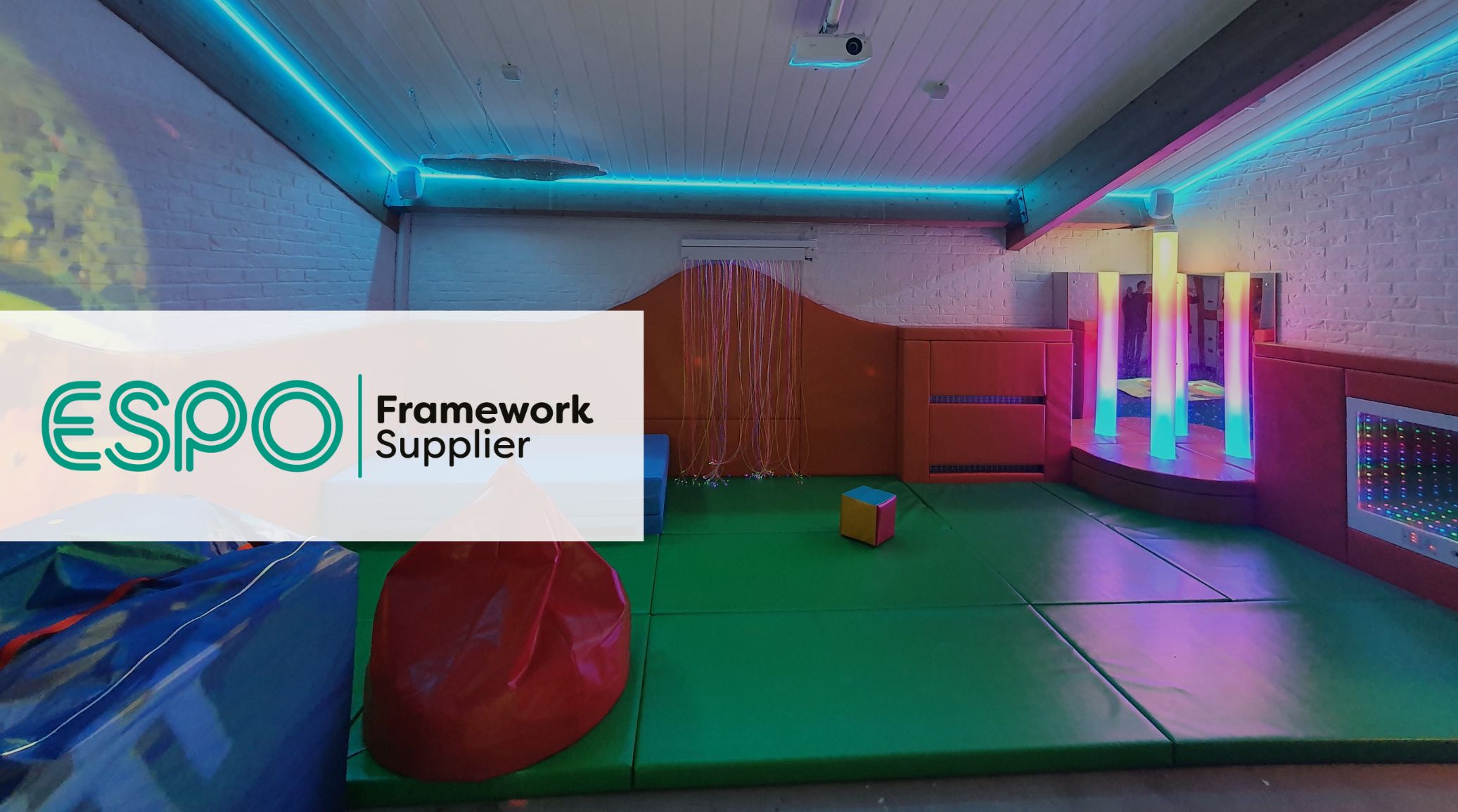Hospitals and Medical Centres can often be overwhelming spaces for visitors. From the bright lights and loud noises to the unfamiliar routines and medical procedures, patients often experience high levels of stress and anxiety.
Research increasingly shows that emotional and sensory wellbeing plays a vital role in healing, alongside clinical treatments. Sensory Rooms are helping hospitals address this need by providing safe, calming spaces where patients can regain a sense of control and comfort – improving their overall hospital experience.
Sensory Rooms in Hospitals
Sensory Rooms are purpose-built spaces designed to stimulate or calm the senses through light, sound, texture and sometimes scent. They are carefully curated to meet a variety of needs and can be adapted for children, adults or older patients.
Unlike in schools, community centres or public leisure, Sensory Rooms within health and social care are primarily focused on relaxation, regulation and emotional support, making them highly valuable in clinical environments and recovery.
Enhancing the Hospital Experience Through Sensory Design
Through thoughtful design considerations unique to each hospital ward, patient room and waiting areas – Sensory Rooms and Sensory Equipment can be incorporated into hospitals to create a calming atmosphere that supports emotional regulation and comfort. From ambient lighting and gentle soundscapes to tactile panels and visual projections, every aspect of the space is crafted to help patients feel safe, supported and at ease.
Pictured: Ground Floor Waiting Area, Ground Floor Patient Testing, Ground Floor Sensory Room and 1st Floor Patient Testing at New Cross Hospital, Wolverhampton.
How Sensory Rooms Support Patients in Healthcare
The healthcare sector is increasingly using Sensory Rooms to enrich the patient experience, helping individuals through features that:
Reduces Stress and Anxiety
By offering a quiet, controlled space, Sensory Rooms help patients manage stress during procedures, long hospital stays or waiting periods.
For children, Sensory Rooms can reduce fear and restlessness during visits for medical procedures, helping them feel more secure and cooperative. Elderly patients may benefit from a space that eases confusion or agitation, especially those with dementia. Patients with sensory sensitivities or neurodivergent conditions, such as autism, can use the room to regulate overwhelming stimuli, improving emotional stability and engagement with care.
Boosts Mood and Engagement
Sensory Rooms can help improve patients’ overall mood by providing stimulating yet comforting experiences tailored to individual needs. Gentle lighting, calming sounds, interactive equipment and tactile activities can lift spirits, reduce feelings of boredom and promote mental well-being.
Patients, including children, elderly individuals and those with additional needs and disabilities, can engage with the environment at their own pace, fostering a sense of control and enjoyment. This active engagement can increase motivation, enhance social interaction and contributes to a more positive hospital experience.
Encourages Relaxation and Recovery
Calm, sensory-rich environments help patients unwind, reduce tension and achieve restorative rest, which can support faster physical recovery and overall well-being. Patients who feel supported in managing their emotions are more likely to participate actively in treatments, therapies and rehabilitation, enhancing the effectiveness of medical care and experience.
Improves the Overall Patient Experience
By addressing both emotional and sensory needs, Sensory Rooms allow patients to feel acknowledged, understood and cared for, which can reduce feelings of isolation or anxiety during their stay. Experiencing comfort and engagement in a personalised environment fosters trust in healthcare providers, increases satisfaction with care and encourages active participation in treatments.
Ultimately, sensory rooms contribute to a hospital experience that is not only more tolerable but also more compassionate and patient-centered.
Pictured: Patient Sensory Room for Hertfordshire Community Specialist Dental Service in Hertfordshire and Patient Sensory Room For The Royal London Hospital.
Key Equipment You Would Find In A Hospital Sensory Room
Within our Bespoke Hospital Sensory Room Designs, we work with each client to create a relaxing space that promotes comfort, engagement and sensory-stimulation. Here are a few of our key features to incorporate into a hospital sensory room.
Interactive Floor Projections
Interactive Floor Projection Systems offer an exciting source of fun and engagement for individuals of all ages, abilities and needs. Using motion-sensor technology, they transform any space into an immersive environment that responds to movement. Available as both fixed and portable units, these systems can be installed in key areas such as waiting rooms, corridors or transitional spaces between wards.
With a wide range of games, educational activities, themed experiences and playful media, our Interactive Sensor Floor provides meaningful engagement and entertainment for patients during their hospital stay – helping reduce stress, encourage movement and brighten their time in care.

Tactile & Activity Panels
Tactile and Activity Panels provide hands-on experiences that promote sensory exploration and support fine motor development. Designed to be interactive, they feature a variety of textures, patterns and more that encourage touch, movement and curiosity.
As wall-mounted units, they can be placed in patient rooms, corridors or dedicated sensory areas, offering continuous opportunities for engagement and sensory-play. These panels are also ideal for space-conscious areas, allowing patients to access sensory regulation even in busier or more overwhelming environments.
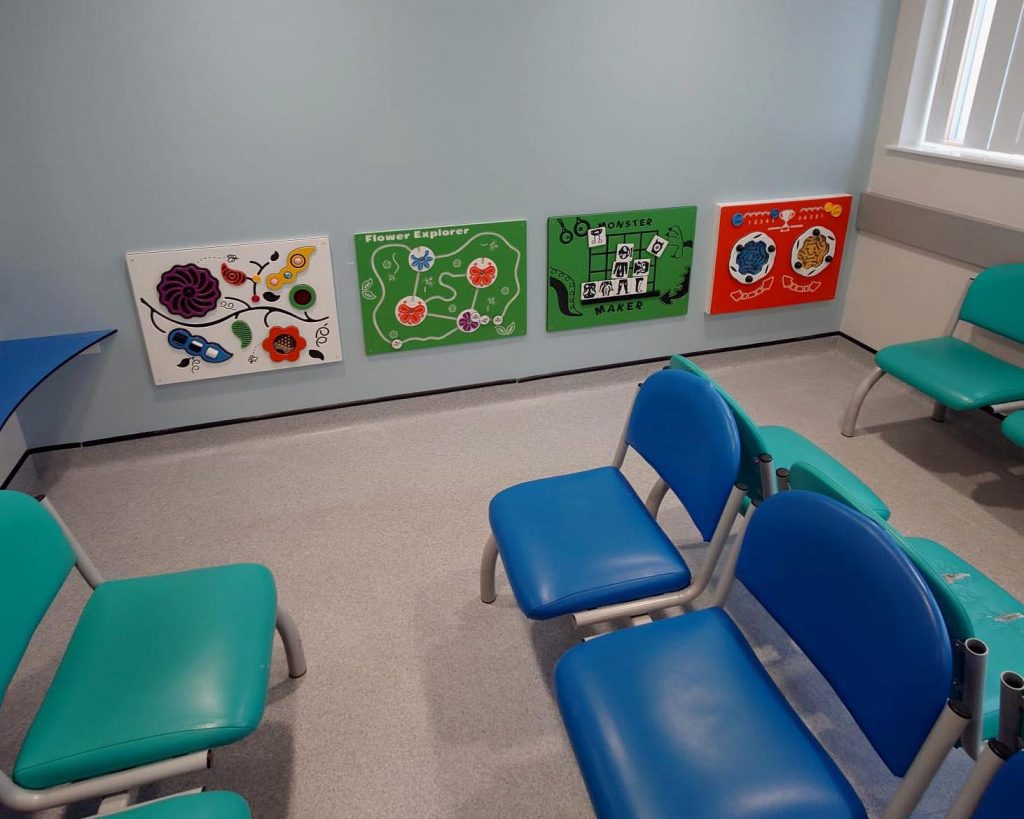
Visual Panels & Mood Lighting
Visual Panels and Colour-changing Mood Lighting within a hospital sensory room create a soothing and emotionally restorative environment through the use of soft, immersive lighting and visual effects. These systems offer not just visual appeal, but therapeutic benefits – calming anxiety, reducing stress and enhancing the overall mood of a space.
Environmental Ceiling and Wall Panels, powered by advanced light‑technology, can simulate natural landscapes, changing sky scenes and more, which transports patients to tranquil, uplifting environments – especially valuable in rooms that lack windows.
A case study by Visualite following an installation in a window-less intensive care unit reportedly led to a significant drop in patient anxiety: over 60% of staff and visitors felt less agitated and staff observed a 35% reduction in patient confusion following the installation.

Protective Padding & Soft Furnishings
Protective Padding provides a safe and supportive environment for patients, particularly those with special needs and/or disabilities who may be prone to outbursts during times of overstimulation, or patients with mobility issues. Designed to reduce the risk of injury, protective padding offers both safety and comfort, creating a secure space where patients can move freely without fear of harm.
Soft furnishings also enhance the overall comfort of the environment with items such as comfy bean bags and rocking chairs – helping to reduce agitation, support emotional well-being and increase comfort levels.
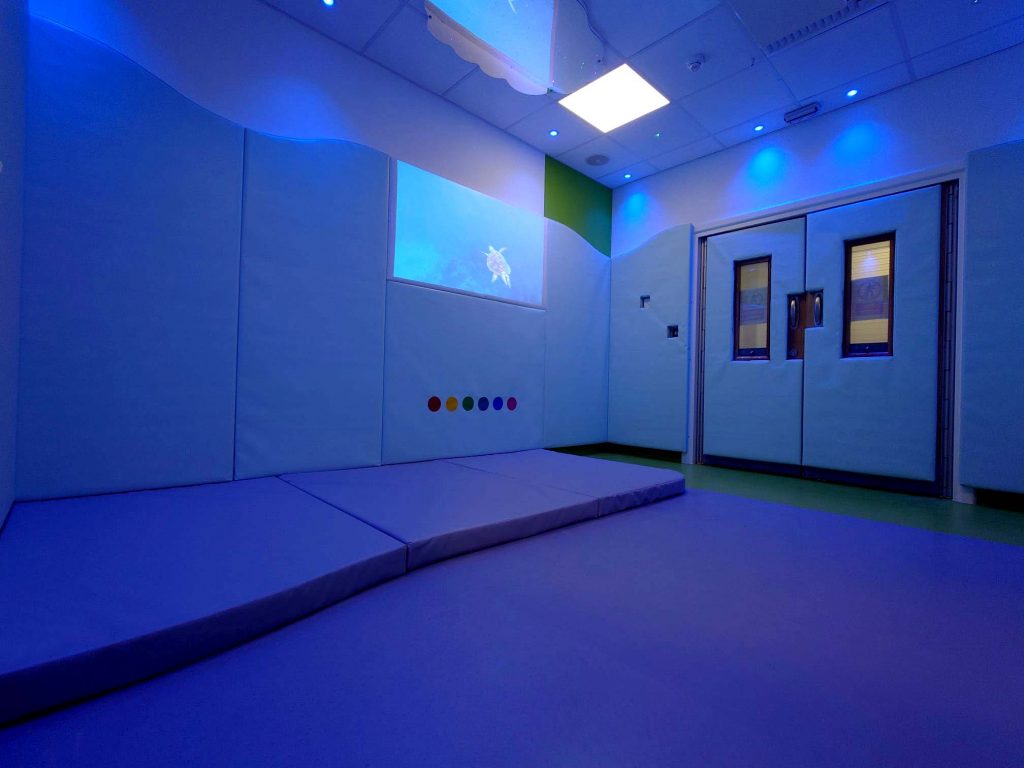
Interactive LED Equipment
Interactive LED equipment brings calming visual effects together with playful engagement, creating a therapeutic yet stimulating experience for users of all ages and abilities. Equipment such as our Borealis Tube and Infinity Panel feature user-controlled switches and sensors that allow patients to change colours, patterns and lighting sequences, encouraging exploration and participation.
LED-based sensory equipment are also highly practical – offering long-lasting performance, lower energy use and reduced maintenance. This combination of interactivity, visual stimulation and durability makes interactive LED equipment a valuable addition to any hospital sensory room.

Portable Sensory Trolley
Portable Sensory Trolleys offer a flexible, mobile solution that brings the core benefits of a fixed sensory room directly to patients, wherever they are. Designed for easy transport across wards, corridors and treatment areas.
Our Sensory Mobile Deluxe is a particularly popular choice in hospital settings thanks to its smooth mobility, durable build and ability to adapt to a variety of patient needs. Equipped with features such as mood lighting, wall projections, interactive elements and a selection of loose sensory toys, the trolley provides instant engagement and calming sensory support on the move. This ensures patients can access meaningful sensory experiences even when space is limited or when they are unable to visit a dedicated hospital Sensory Room.
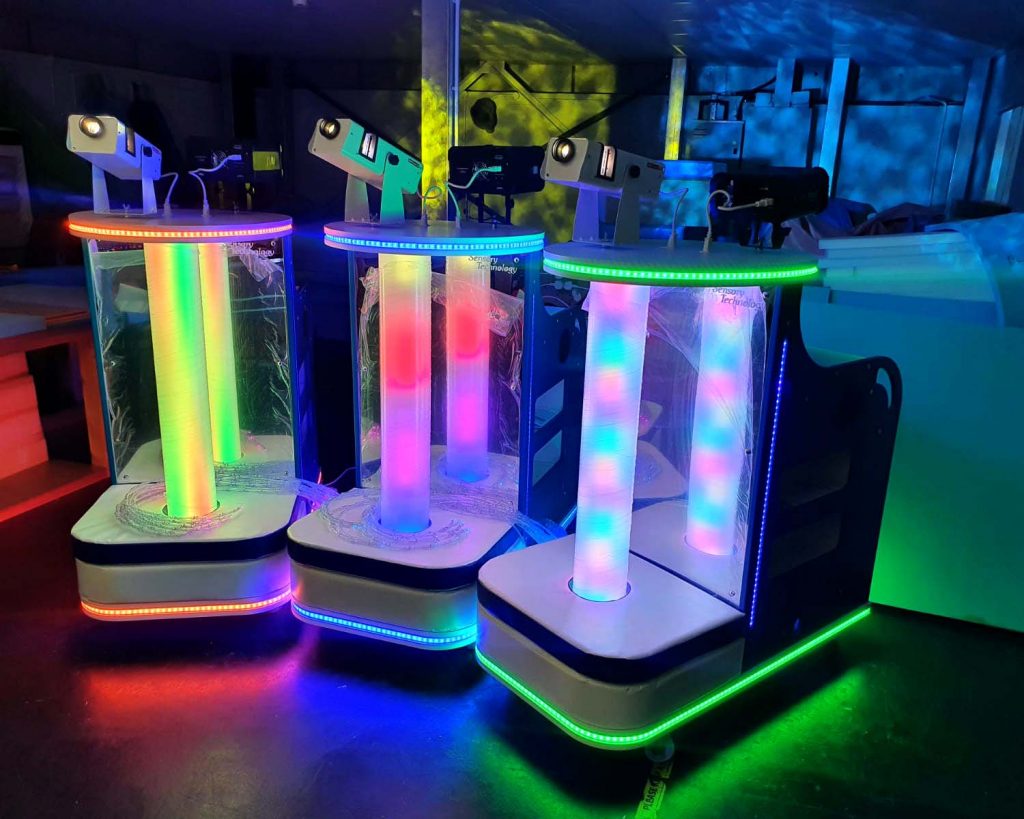
Why Sensory Environments Matter in Healthcare
Incorporating sensory solutions into healthcare environments offers significant benefits for patients, staff and visitors alike. From calming lighting and interactive LED equipment to tactile activities, protective padding and portable sensory trolleys, these thoughtfully designed tools help reduce stress, promote engagement and create more supportive, enjoyable spaces. By integrating sensory experiences throughout care settings, healthcare providers can enhance well-being, improve patient outcomes and foster a more positive, inclusive environment for everyone.
Want to learn more about Hospital Sensory Room solutions? Read our case study below on the bespoke design and installation we completed at Grange University Hospital, Wales.


